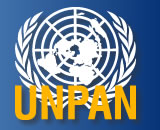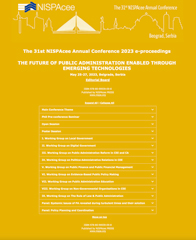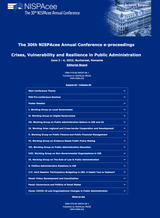| WG_News :: About WG :: Coordinators :: Activities :: WG_outputs |
Research Protocol 2009
Introduction
Since 2001, when the Working Group on Public Sector Finance and Accounting was established, various topics related to local government finance and intergovernmental fiscal relations were explored. Gradually we have moved from broader topics such as local government revenue capacity or intergovernmental transfers to more specific topics such as the property taxation, which was researched last year. The topic of “Municipal asset management in CEE and CIS countries” is the outcome of the discussion of the working group members in Bratislava in 2008 as this research area was generally perceived as substantial, worth studying, but neglect in most countries so far.
Property is one of the basic pre-conditions for autonomous local government. All the post-communist countries went through the process of public property devolution, which started after the new democratically elected parliaments approved the basic laws. Regardless the approaches to property devolution the individual countries applied, at the moment municipalities in all the countries in the region own various types of property and have to manage it.
It is important to stress that municipal property is extremely heterogeneous and that in many countries municipal assets may be very large comparing to the annual budget revenues and expenditures. Municipal assets include: (i) physical infrastructure necessary to the performance of government functions, (ii) other types of real property, including publicly owned housing and vacant land, (iii) public enterprises that supply services like electricity, water and wastewater removal, telephone service etc. (iv) enterprises that provide what would otherwise be purely private services, like restaurants, hotels, industrial centers, etc., (v) shares of private companies (which may have been given to municipalities as part of the privatization process), (vi) cash holdings, and (vii) receivables (see Kaganova, 1999, p. 2).
The main goal of this research is to review experience in municipal asset management in the CEE and CIS countries in the context of fiscal decentralization. The final outcome of the research should be 10-12 country papers using the enclosed research protocol and presented in Budva in 2009. The aim is to issue a book, which would include a final version of all accepted country studies and a comparative study as a first chapter of the book.
Structure of the country papers
The papers have to be up to 12,000 words long (including references and appendices). The authors are highly encouraged to be prepared to produce a shorter version of up to 8,000 words as journal articles. Please, try to adhere to the set limit, as this enables preparation of any intended future publication.
As for the style of the paper, please, follow, the NISPAcee Manuscript Guidelines (http://www.nispa.org/files/conferences/2007/Nispacee_Manuscript_Guidelines_2007.pdf)
The national papers should have the following structure:
1. Introduction
In the introduction the authors have to clearly set out the goals, aims and objectives of their research, what might be the main issues (research questions) that they plan to tackle and how this is going to be done (research design and methods), with a list of expected outcomes. It is acceptable to discuss very briefly the main problems dealt with in literature and how this may relate to their research. It is expected that all authors will demonstrate a very good knowledge of related literature in both local language and in English. At the end of the introductory section the author should set out the remaining of the paper (paper structure).
2. Municipal property
This chapter should present an overview of the situation in your country and it should be a background for the case study which will be the key part of the paper. The paper should be primarily focused on the current situation, thus no extensive description of the past development is needed. The same applies to the legal framework; it should be clear what kind of legislation regulates this area; however no detailed legal analysis is required. Also, it may be necessary, in order to facilitate good understanding, to include information on the wider institutional framework. In some cases the nature of the state may dictate many features of the property-issues relationships.
Please address the following issues:
1. property transfer
How the property was transferred to the municipalities and what were the main principles? Outline the process including the major problems or difficulties and stress how it influenced the current situation.
2. legal framework
Describe the legal framework of municipal property. How is it regulated at the national and municipal levels? Which issues are regulated centrally and which are in the competence of the municipalities?
3. asset classification
Identify major types of assets owned by local governments and describe how they are classified, i.e., what type or types of classification are used and for which purposes.
4. nation wide time series data.
What kind of aggregate data on municipal assets are available? Is it possible to evaluate the volume and structure of municipal assets and their development? Please, state any methodological problems connected to the presented data, such as problems with valuation, changes in the legislation etc. In case of no availability of acceptable data series, try to present some estimates or so.
3. Case study
This chapter is the core of the paper. We propose to elaborate a single case study and there are several reasons to do so.
First, the case study method is well suited for an exploratory research (see Yin, 1991), it involves empirical investigation of a phenomenon within its real context and it uses multiple sources of evidence. Therefore it enables us to gain a rich understanding of such a complex issue as municipal asset management. Combination of various data collection techniques, including interviews, observation or documentary analysis, and subsequent triangulation of collected data can ensure sufficient rigor of your findings and conclusions. Of course it is necessary to avoid unjustified generalizations.
Second, elaboration of a case study is feasible even with limited resources and it is flexible, i.e., appropriate for scholars comming with different background. At the same time, this approach will allow elaboration of more papers from the same country.
Although the case study method is proposed, if the interested author prefers to use a different method for collecting, presenting and evaluating primary data, there is no restriction to any appropriate approach. The chosen approach has to be, however, very specifically described in the submitted abstract.
This chapter should first characterize the selected municipality and than focus on one selected asset type.
The selection of the studied municipality must be based on its possession of a wider diversity of municipal assets (non marketable public buildings and land, marketable real estates, shares and bonds, municipal owned public service or utility companies etc.)
The first sub-section has to give a short overview of the selected municipality by geographic location, size of population, economic structure (the feature of the place e.g. industrial city, religious centre, tourism centre etc.). After that it needs a short description of its financial management and responsibilities of the municipality. The description should be based on the table of the revenues and expenditures over several years. The next part of this sub-section has to describe the organizational structure of the municipal office in relation to asset management, i.e. to identify who is responsible for what. Is the asset management rather centralized or not?
The second sub-section of the case study will focus one particular type of asset and will deal with its management, i.e., various aspects of property acquisition, holding and disposition.
There are two general approaches to or goals of asset management (see Kaganova et al., 1999, p. 11-12): (1) provision of public goods and services and (2) support of local economic development and source of budget revenues. Which one is applied in the studied municipality? Is it possible to make such a clear distinction in the real world?
As a result of the case study some good and bad practices can be identified which have local and/or national policy concerns.
4. Conclusion
The last section has to sum up all the major issues raised in the paper and to make a clear assessment .The papers have to be academically strong, but at the same time policy-oriented, offering a credible policy advice. The concluding section is also to point out possible avenues of future research, trying to align the current trends in (Western) literature to the specific developmental experiences of CEE and CIS countries and their national specifics.
The interconnection of the findings about the general situation in the country and the specific experience in one municipality will provide a good starting point for formulation of your conclusions and possibly policy recommendations. At the same time it offers larger space for comparison of different countries than would be possible if the case studies were not included. And last but not least, the proposed approach will limit descriptive part of the paper and strengthen its empirical one.
Literature
Bobcheva, N. The Quest for Additional Revenues: Improving Municipal Property Management in Bulgaria in Guess, G.M. Fast track: Municipal Fiscal Reform in Central and Eastern Europe and the Former Soviet Union. OSI/LGI, 2007, available at http://lgi.osi.hu/publications_datasheet.php?id=363
Kaganova, O. et al. Municipal real property asset management: An overview of world experience, issues, financial implications and housing. The Urban Institute, Washington D.C., 1999, available at http://www.worldbank.org/html/fpd/urban/mun_fin/toolkit/105p.pdf
Kassó, Z and Pergerné-Szabó, P. in Kopányi, M., Wetzel, D. and El Daher, S. Intergovernmental finance in Hungary: A decade of experience 1990-2000. IBRD, 2004, available at http://lgi.osi.hu/publications_datasheet.php?id=270
Péteri, G. From Usage to Ownership: Transfer of Public Property to Local Governments in Central Europe. OSI/LGI, 2003, available at http://lgi.osi.hu/publications_datasheet.php?id=232
Young, E. and Quinn, L. Writing Effective Public Policy Papers: A Guide To Policy Advisers in Central and Eastern Europe. LGI, 2002, available at http://lgi.osi.hu/publications_datasheet.php?id=112 (available in more languages)
Yin, R.K. Case study research: Design and methods. Stage Publications, New York, 1991




 Price:
Price: 








